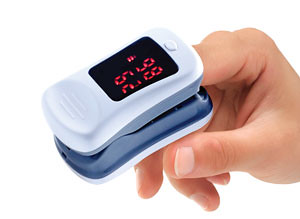 |
Oxygenated blood and non-oxygenated blood absorb light differently. The pulse oximeter takes advantage of this phenomenon and readily shows on the screen how much oxygen there is in the blood. The other reading on the screen is the heart rate. Since an adequate flow of blood to the finger is necessary, the pulse oximeter will give incorrect readings if someone has cold hands or is in shock. Nail polish also interferes with accurate reading.
In a country where cardiopulmonary (heart and lung) diseases like chronic obstructive pulmonary disease, pulmonary TB, rheumatic heart disease etc are so prevalent, this device is clearly helpful. Today a pulse oximeter costs only Rs 5,000 so even hospitals and clinics in remote corners of the country can afford one.
Many pilgrims and trekkers who are travelling to high altitudes also carry this device. When people ascend to higher elevation, the barometric pressure decreases, and together with this the saturation of oxygen also falls. Unfortunately, there can be a wide range of correct values for a particular individual to state with confidence whether the person has adequate oxygen saturation or not for that altitude without symptoms. So just basing the diagnosis of altitude sickness on the reading of the pulse oximeter is discouraged. The oximeter reading needs to complement the patient's history.
In other words, the diagnosis of altitude sickness is history- based, and the pulse oximeter reading in addition to the history should be used like a confirmatory test. If you carry this device during a high altitude trek or pilgrimage, it may be best to use it only if you have actual symptoms of acute mountain sickness (excessive tiredness, headache, and nausea). Otherwise , the pulse oximeter may serve to trigger an unnecessary anxiety attack in predisposed people at high altitude.


